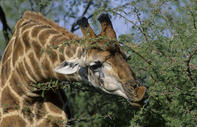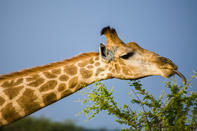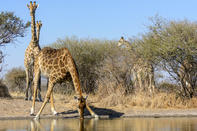Thorny Issues
Giraffe are classic browsers, their long necks giving them access to the highest of foliage. They do however bend down to ground level in order to pick up bones or soil that they chew to supplement calcium and phosphorous that is lacking in their diet.

This is called osteophagia and geophagia respectively. Giraffe have some special adaptations that suit them to feeding high above the ground and on thorny vegetation.
The evolutionary arms race that exists between herbivores and their ‘plant-prey’ caused the trees that grow in more fertile clay soils (that line the band lower down the slope) to produce thorns. These trees e.g. Acacia spp are highly nutritious because of their growing conditions and therefore sought after by herbivores.
Thorns are most effective against large herbivore mouthparts (over other options like chemicals) and deter herbivores from feeding excessively on any given tree. Herbivores have developed mechanisms for getting around the discomfort of feeding on thorny plants and the giraffe is an expert in this field.
Giraffe have lovely lengthy eyelashes which protect their eyes when they push their heads into the thorny or twiggy canopies of trees to get their food.
Little Food Competition

Giraffes’ long necks give them a height advantage and they can access a two-metre band of vegetation out of reach to all other herbivores except elephants. The biggest bulls can reach almost six meters high. Because of the height difference between sexes, male and female giraffe feed in different zones and therefore do not compete for food with one another. Bulls tend to feed higher up, stretching themselves to their height limit while cows tend to utilize lower browse. Bulls will also take to taller, denser woodland than cows.
The feeding techniques of giraffe can affect the growth form of trees. Continuous pruning of young trees can stunt their growth and in favoured species of taller trees, giraffe may be responsible for creating a waistline around the middle of the tree giving their favourite trees telltale hourglass shapes. Giraffe have a modified atlas-axis joint at the base of the skull that allows them to tilt their heads vertically to reach upwards for forage.
Tongue and Lips

The length of a giraffe’s tongue is 45 cm and it can extend a great deal beyond the mouth. This gives giraffe an additional height advantage. The tongue is prehensile (able to grip) and this enables the giraffe to use different feeding methods.
They are able to strip whole branches of their leaves by wrapping their tongue around a branch or they might grip and pluck a particular bunch of leaves or leaf. The tongue is very rubbery and not easily penetrated by thorns. It is also coated in profuse saliva.
The narrow muzzle with its lithe upper lip enables giraffe to pick individual leaves from between thorns. Since giraffe are selective feeders needing to consume high quality forage to accommodate their ruminating digestive system, this is an important trait. Horny papillae (bumps) protect both the lips and tongue from pricks from thorns.
Water Pressures

Giraffe may drink every two or three days if there is water around but they get most of the moisture they need from the green leaves they eat. When giraffe do drink, the process is a complicated one as bending down potentially subjects their brains to an over-load in pressure.
A giraffe’s brain sits up to 5m above ground and almost two meters away from its heart which circulates 60 litres of blood every minute.
To counteract a potential flood of blood to the brain, giraffe have a network of small capillaries that dilate and constrict to control the flow of blood to the brain when the giraffe bends down and subsequently the flow of blood back to the heart when it stands up again (to eliminate the chance of a giant head rush!). They also possess valves in the neck to assist this process.
By Megan Emmett